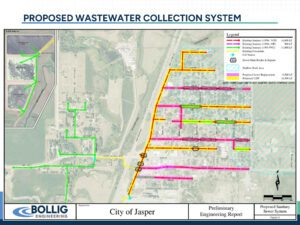|
|

This map shows a proposal from Bollig Engineering to address issues with the city of Jasper’s wastewater collection system. The proposal calls for a combination of cast in place pipe lining and replacement of some sections of the system. Source: Bollig Engineering
The Jasper City Council during its Oct. 14 meeting took steps to obtain funding for proposed infrastructure work.
Council members voted to apply for funding from the Minnesota Department of Employment and Economic Development (DEED) and approved a task order for Bollig Engineering to seek funding sources, apply for funding and administer funding. The task order for Bollig includes an annual fee of $5,000 and a fixed fee of 5 percent of the total amount of funding secured and approved by the Council for funding administration services.
Jordan Odegard, project engineer with Bollig, presented an existing condition review of the city’s drinking water source, water tower, water distribution system, wastewater collection system, wastewater treatment facility, storm sewer system and streets. He also presented project alternatives for the water tower, water distribution system and wastewater collection system.
Among the information presented to the Council was that the Minnesota Department of Health and Lincoln Pipestone Rural Water, from which the city gets its water, are proposing eliminating meter pits like the city has and installing above ground meter buildings. He said an above ground building will be included in the preliminary engineering report that’s being developed.
Odegard said the city’s water tower was inspected earlier this year and the interior coating below the water line and the exterior coating are in poor condition. He said it was recommended that the coatings be addressed within the next five years, and that some other repairs be made to comply with Occupational Safety and Health Administration and American Water Works Association standards.
Odegard said Jasper’s water distribution system is mostly cast iron pipe from the 1950s. While it’s around 75 years old, he said it’s mostly in “good shape.”
Most of the city’s wastewater collection system is made of clay pipe from the 1950s. Odegard said there have been breaks and repairs over the years, but there are issues that have not been addressed.
At the city’s waste water ponds, the Minnesota Pollution Control Agency identified frequent unauthorized discharges due to inflow and infiltration into the collection system, lift station bypasses and wastewater pond seepage.
Regarding storm sewer, Odegard said the city primarily uses curb and gutter, which seems to be working well due to the city’s topography. He said there were some drainage and culvert issues along State Highway 23 that the city could contact the Minnesota Department of Transportation about.
Most of the city’s streets were listed as being in fair condition.
Project alternatives for the water tower included doing nothing, replacing it or rehabilitating it. Odegard said the estimated cost to address the water tower needs and bring it up to current standards was around $1 million to $1.2 million. He said the costs to replace and rehabilitate the water tower would likely be similar due to the style and age of the tower.
Project alternatives for the water distribution system included doing nothing, replacing select portions and full replacement. Odegard said the areas that would be replaced would be in areas where the sanitary sewer would also be replaced.
“The thought is that where the sanitary sewer would have to be fully open cut, the water main would get replaced as well because we’d be tearing up the street anyway,” he said.
For the wastewater collection system, it showed options including doing nothing, cast in place pipe lining with some select replacement, and full replacement.
Laura Ostlie, funding program manager with Bollig, presented a variety of funding options including the United States Department of Agriculture (USDA), Minnesota Public Facilities Authority (PFA), Small Cities Development Program (SCDP), Minnesota Department of Health, Minnesota Pollution Control Agency, Minnesota Rural Water Association, Pipestone County, Minnesota Department of Transportation, state bonding and Congressional Directed Spending Requests. Ostlie said there would likely be a combination of funding sources used.
She said a pre-application for DEED’s SCDP is due in November.
“Even though you don’t have your PER [preliminary engineering report] completed, we will start working with this pre-ap based on what we know and we’ll work directly with Jordan and the rest of the team to get the necessary information to at least get you competitive enough to pass that first pre-ap portion,” Ostlie said.
City Council members approved a task order in March authorizing Bollig to prepare a preliminary engineering report and environmental report for a cost of $45,000. Odegard said he would bring final costs and information for the City Council to consider before submitting the preliminary engineering report.
“You guys are always in the driver’s seat on what gets done for your project,” he said.
In other business, the City Council:
•Approved a 2026 law enforcement contract with Pipestone County. The contract amount is the same as last year at $52,287.
•Scheduled a special meeting for Nov. 20 at 6:30 p.m. to discuss the 2026 budget and levy.


